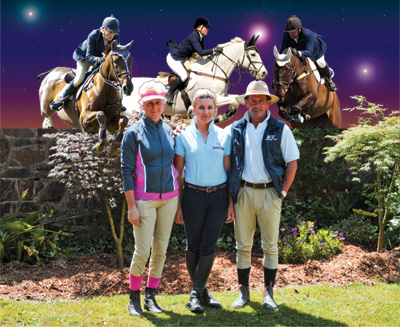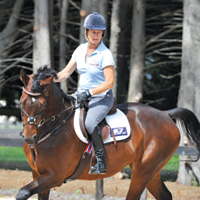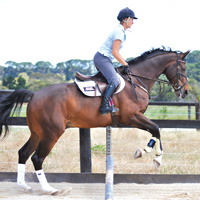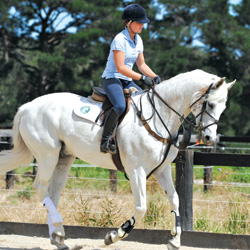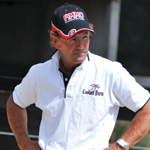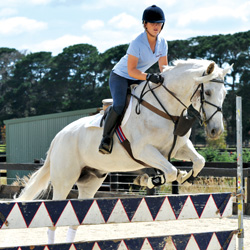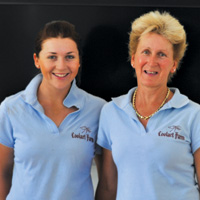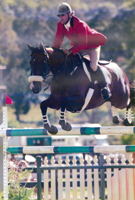Part 2 with leading Australian jumping coach, Jamie Coman
We are back at Coolart Farm on Victoria’s Mornington Peninsula, where Jamie Coman and his wife, Sue and daughter, Hayley have set up their showjumping centre. Jamie is in a familiar role, standing in the middle of the arena coaching: this time it is Sue riding Laura Santry and her mother, Sue Darvall’s handsome bay Warmblood, Marine, while Hayley is mounted on her front-liner, Just Lately.
They are two very different horses. Hayley’s grey part Connemara pony is never going to be described as elegant, but he is one of those rarest of creatures, a true schoolmaster. Slightly too feral on the flat to make it as an eventer with his owner, Scott Keach, Just Lately has taken Hayley through the ranks of Young Riders and all the way to her first two World Cup starts last season. Sue’s Marine was quite a star in Young Horse classes, but now at the age of eight is showing real talent as a jumper and has just had his first 1.25 start the previous weekend.
As usual, Jamie is a stickler for getting the flatwork right first. “Get him working on the bending lines, with that snaffle you can really take him and work him, work him on the left and get the bend.”
Jamie usually rides the horse himself, and he is being cheeky: “He makes you look good that horse, Susie, I tell you…”
“Marine is going to be a nice horse, Jamie comments. “He is good on the flat, he works well and he always looks a good picture. He’s a bit uptight in himself, but he’s really learning his trade well. He is quite a careful jumper, a little on the looky side, but also very brave as well which is good because you always want that fine line between looky and also brave.”
He has that tendency to lock into a “dressage” frame when things get confusing…
“Yeah, what they do is they come into the rectangle frame – the “dressage” frame – and I want the oval frame. It is just a matter of teaching him to reach into the bit. He’s starting to do it, but as I commented when Sue was riding him around, it was great he was reaching but he can’t do it on a loose rein. He has to have a connection so he learns to hold your hand deep and work over the back. With another six months of training, and more time in the ring, he’ll learn to let go, and travel deeper, then we’ll see the best of the horse.”
He’s a horse that has done a lot of work at home, now he has to get some competition miles…
“Most definitely. He’s done a lot of work at home over the last three years and has had limited outings, now we’ve got to fast track the competition and get him exposed to every arena we can find.”
And surprise, surprise, we move on to a little pole work. Gee Jamie, can’t you come up with a few amazing gimmicks to make my story more interesting…
“I don’t vary much from the basics, it’s just making the basics very good.”
At the end of the pole lines, Jamie still wants Sue working on that flexibility: “At the end of the line, work him on a ten metre circle so he really accepts working around your leg.”
Time to jump:
“I like this exercise: ten feet from a rail on the ground to a nice little vertical, two strides to the next rail on the ground. You can jump that either way – jump the canter pole to the fence balanced and make the two strides happen, then come back the other way, do the two strides slowly, then still keep the shape in the horse’s jump without letting him jump out the back because you’ve still got the rail on the ground ten feet away. I find that a good exercise.”
“Slower Sue, you always want to be a bit quick on the two away…”
Now it was Hayley’s turn, and Jamie wanted her sitting deeper on the grey: “Not so strong in your thigh, sit into him.”
Hayley gets Just Lately a little hurried in front of the vertical, and stops the horse: “Keep the reins a little shorter, and come again. Stay very tall, stay very soft.”
And they take the rail nicely, but the perfectionist is not satisfied: “Do it again, and keep your thumbs on top of the reins. Take the reins up nicely, don’t kill the canter, nice and direct, stay soft, stay soft, stay soft. That’s good when he’s slow – you don’t get quick with your shoulder.”
“It’s the old story, if the horse is quick, you stay slow and try and even out the picture. If you get quick with that horse, you end up getting in front of it, shooting away, and then the horse runs away after the jump and then you end up with an argument between horse and rider. Patience… if they want to be quick, you have to learn to slow yourself down, and allow the horse to learn that it can be steady.”
You and Sue are both serious students of jumping bloodlines, so what do you get for your daughter to ride… a Connemara cross!
“It was unusual how that came to be. Scott Keach is a friend, and he didn’t want to sell the horse, so we leased him for Hales. He’s got a few little quirky issues but he looks after my daughter. He’s brave and he’s been a wonderful young rider horse and now we are getting the bonus of moving up to small Grand Prix. We have even been able to get two World Cup rounds out of him, which is a real bonus. I certainly didn’t expect that, I thought he’d make a good Mini-Prix horse. I think we’ll always have to be careful about what World Cups we start him in because we don’t want to break his heart. If we can find the right World Cups, just to give Hayley exposure at that level because when you for a ‘WC” in front of a class, riders ride them differently – and they have to get used to those different pressures. So far Hayley has coped really well, I was impressed in Adelaide and Gawler, the two World Cups, she rode them very well. Really mature and focused…”
What were you concentrating on with Hayley and her horse in the lesson?
“The horse has to learn to slow up, and stay straight. He has always had a left slide, a left drift, so we are forever working on that: just reminding him, be straight, be centred, stay in the air, don’t be too quick off the ground. Let him learn to land and canter away, he likes to land and run away. It’s a matter of getting Hayley into a frame of mind that she starts to trust him, not straight away grab him and say ‘don’t run away’ – some horses you do that with them and they get more scared. You are better just to let them chill out a little… I got her to hop into a light seat for a while, stop the work for a while and have a think about things, and then when we came back inthe second session, he was great, much softer, and you have a smiling rider and a happier horse.”
On to the next exercise:
“It’s a the triple combination of oxer, nine feet rail on the ground, nine feet to a vertical, nine feet to a rail on the ground, nine feet to another oxer. This exercise is very good at teaching them to stay slow in the air and learn to hold their shape because they know there is a pole on the ground, but also be in the air and be careful, and hold it all the way through. Sue’s horse gets a little quick doing that by the last part, only because he doesn’t trust himself that he can stay soft and actually sit on his hocks. He’d rather just try and shorten his neck and still keep the same length of stride forward which makes his jumps always a bit quick and crampy. We’ve been working on it, and last weekend at the show, he had quite a big treble, and he jumped it beautifully. What we are doing at home is working when we take him out…”
‘Slow’ was seemingly your message of the day – to both the horses and the riders…
“You have to be slow, you want hang-time in the air, not just getting the job done – I don’t want them just to shift their legs, I want them to be classical and slow in the air… a beautiful picture. The horses today were a little quick I thought. Hayley’s horse is just back in work, he is always more like a pony, he just wants to get the job done, but by the time we finished our session today, he was getting back to where I like him.”
Hayley Coman – Born to Jump
Your Dad is a showjumper, your mother is a showjumper, were you ever tempted to run away and become a super model or a real estate agent…
“Not really. I suppose people looking from the outside, might imagine I’ve been forced into the showjumping, but I’ve been riding since I was young, and I love it with a passion. I did take twelve months off after I finished my HSC and went to France and worked in a ski resort in the Alps, and… it killed me to be away from the horses. No – riding is wonderful, I wouldn’t choose to do anything else.”
You basically manage the operation here at Coolart Farm?
“Since we’ve moved down here to Victoria, I’ve got quite serious about the riding and training, and got into working with the ones we’ve bred. Mum and dad are so busy teaching that I’ve taken over the management of the horses and the young ones, clients’ horses that are coming in. I’m starting to get my own clients, I’m trying to branch out so I am not so attached to mum and dad, so I’m separate. It works well, my parents travel and are away a lot, I’m based here seven days a week, and take care of the property.”
Is it difficult at times with your trainer is also your father?
“Dad and I train really well together, we are both very similar and have the same frame of mind. We both want it to happen so we can be quite tough on ourselves and each other. I don’t actually train with Dad that much, no-where near as much as everyone thinks. I have the occasional lesson before we go to shows… most of the training I do with Dad is in the clinics I got to as a member of the State Squad… I had to get on the State Squad and pay for the clinics to have lessons with my dad!”
“So we don’t have a lot of one-on-one sessions, but when we do, it is usually quite productive, we both have the same thoughts on how we want things to happen. There’s always that good factor, I guess there is always the tension of father and daughter… but it works well.”
Your grey horse, Just Lately looks a cheeky little customer?
“He is a Connemara / Thoroughbred cross. He is very hot and very sensitive, very sensitive to anyone on the ground, to noise, anything different. He is very tricky. He is quite strong, he’s had a lot of bit changes and he can go through three or four bits in a show but he’s a little star, he’s a gem. He has a heart the size of himself, he’s had his first couple of World Cup starts, and he was just fantastic. He was an eventer originally, but he was too hot for eventing, his dressage wasn’t good enough. His owner Scott Keach moved to America and asked me if I wanted to take him on. Together we’ve gone through Young Riders to Mini-Prix to Grand Prix… he’s a great horse, and my best friend.”
Sue Coman – Sharing the Passion
“For us, showjumping is such a passion… we work all day together. Sometimes you need time off, and you’ve got your coaching and your pupils, but we do rely a lot on each other with the training – and on Hayley too, it’s great…”
Was it a big challenge moving down from NSW to Victoria?
“It was, and I was probably the doubter, because being from Queensland I love the warmth. I always loved doing the Victorian shows but I thought living down here might be a bit harder. Jamie was doing clinics at Marine Park and he said, come and have a look around and see if you like it, and I loved it. I love teaching the young riders, juniors and amateurs, they are great to teach, they want to learn, and there’s lots around here who are really keen. The shows are great for us at this stage because we’ve got a lot of young horses coming through, neither of us have Grand Prix horses at the moment, but there’s a lot of variety. Within an hour you can have a choice of several competitions, most weekends.”
But you still have the ambition to get out on the Grand Prix circuit again?
“It would be great to have a horse at that level, love it. It’s a long way to go, but a couple of the youngsters that we’ve bred, we’ve got big hopes for them. That’s my aim at the moment, to produce a horse for the Grand Prix and the World Cups, because I love that end of it – like anyone who rides all the time – but at the moment I have to be happy with the baby classes. It’s nice to think you can get on and actually jump something bigger than one metre twenty for a change, I’m really looking forward to that.”
That was a sweet horse you rode today?
“A very nice horse. Laura has done a really good job with him. Jamie has taken over the ride for the last three or four months and he has come a long way in that time – he’s gone from D to C. He wants to do the right thing and he’s a lovely horse to sit on. Scope-wise, he needs to learn to be a little softer but that will come with time. We’ve got big hopes for him too.”
Jamie Coman – Off to Europe
“We were very fortunate to meet Mary and George Reed when we moved to Camden. Mary was like a mother to Sue, and a grand-mother to Hayley. She had a fantastic eye for a horse – Thoroughbreds, Ponies, Hacks, she had a great eye, and you just had to listen to her because she had such knowledge and experience. She would tell you something and you might not take it in at the time, and three months later, yes, she was right, that is a good horse… she was not very often wrong. The Reeds owned a number of good horses that we rode.”
“We moved to Camden in 1988 and in 1997 I made my first trip to Europe. I had the opportunity to try for the World Championships with Modra (photo), owned by Cheryl Hunter. At my own expense, I was able to go over and train with our then National Coach, Albert Voorn. I was looking for that sort of opportunity, it would have been nice if the whole family had been able to go, but it wasn’t possible. I just loved being over there. Modra carried me around Europe – everywhere – he was always there in the placings. I don’t think I realized at the time just how good he was.”
“As it turned out, he was sold two weeks before they named the WEG team, but still I’d had that experience of riding in Europe.”
Albert Voorn was a bit unusual in his coaching…
“His coaching was pretty much here it is, this is the way – there was no left or right, that was it, there was one program and that was that. His way was great for my riding, I loved his classical riding style, I thought he could have brought a lot to Australia in that way, teaching our riders to be super classical, but he was dealing with a lot of Thoroughbreds in Australia, and he just didn’t have the feel for Thoroughbreds. He could ride them but he couldn’t explain what he was doing to make this horse go. You’d get on and try to ride the horse the same, and it wouldn’t happen. But he was such a talented rider…”
“His system was pretty well that you left the horse to its own devices. You left them where their nose wanted to be, if they were fresh you lunged them until they tired – there was no real flat or dressage work. I expected to go there and train dressage and have the horses very round and all that, but he wanted to keep it very natural, where the horse was, that was how it was, stay in the one rhythm with your canter stride…”
He didn’t do any lateral work did he?
“Very little but then again, every horse that he had, he’d taken on, they’d been trained as young ones and obviously knew that work. But I think our riders here in Australia, needed to do more flat work. The jumping side was fantastic, we just needed to do more dressage with him. He needed to show us more dressage riding but that wasn’t his thinking – he said, just ride the horse naturally.”
“I stayed at Albert’s for eleven months, then when the horse was sold, I came home. I met so many coaches and trainers while I was over there, and I kept in touch, not only with Albert, but with the other trainers I’d met. I came home and we had another horse that we thought could go to the Games, so I came home very focused and worked very hard – and made it, that was the Sydney Games with JJ Zazu.”


